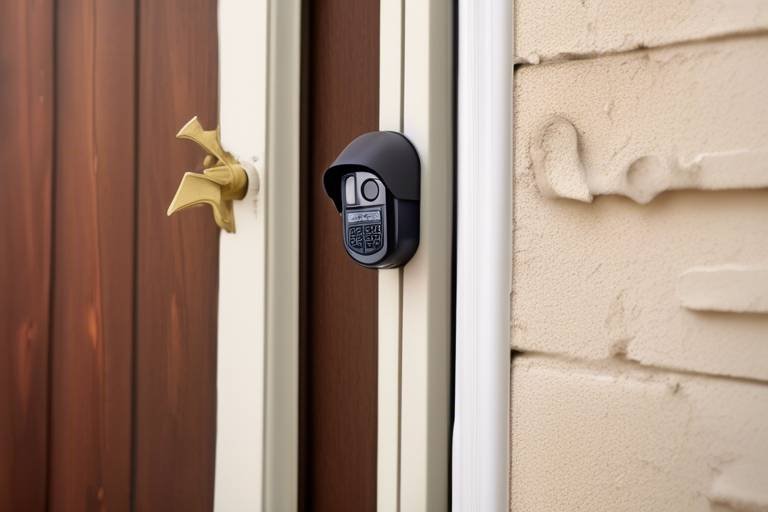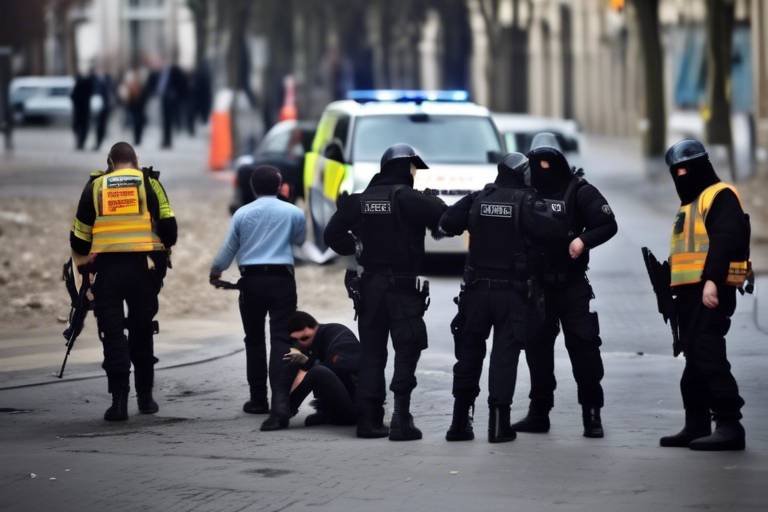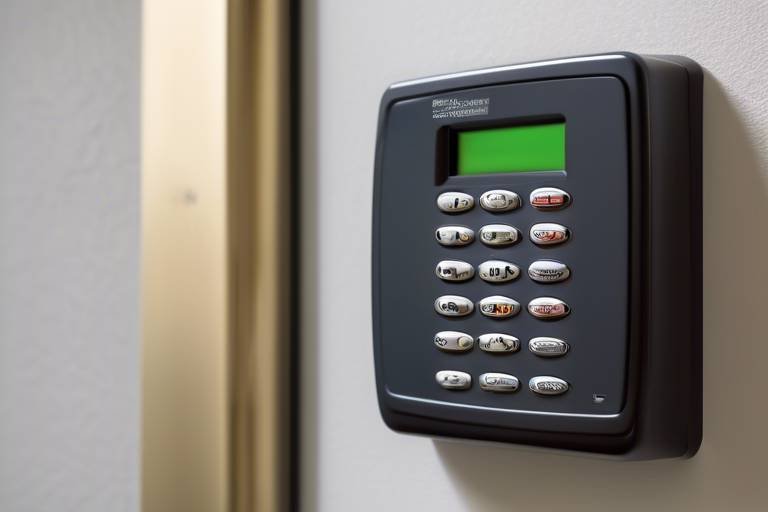When Home Security Fails: What to Do?
Home security systems are supposed to provide us with a sense of safety and peace of mind. However, what happens when these systems fail? It's a situation that no homeowner wants to face, but it’s essential to know how to respond effectively when it does. The first thing to remember is that staying calm is crucial. Panicking can cloud your judgment and lead to poor decisions. So, take a deep breath and focus on the steps you need to take to regain control of your safety.
Understanding the nature of the security failure is vital. Was it a malfunction of the alarm system, or did someone breach your physical security? Evaluating what went wrong can help you determine the immediate risks involved. For instance, if you find that your door was forced open, it’s critical to assess whether anyone is still inside your home or if valuables are missing. Assessing the situation can also help you decide whether you need to contact authorities right away or if it’s safe to do a more thorough check of your property.
Once you’ve assessed the situation, the next step is to contact the authorities if necessary. Knowing when and how to report a security incident can make a significant difference. If you suspect a break-in or notice suspicious activity, don’t hesitate to call law enforcement. They are trained to handle these situations and can help ensure your safety. Remember, it’s better to be safe than sorry, and reporting an incident can also help prevent future occurrences in your neighborhood.
In the unfortunate event of a security breach, documenting evidence becomes vital. This step can aid law enforcement in their investigation and possibly assist in any insurance claims you may need to file later. Start by gathering any relevant information about the incident. This includes taking detailed notes about what happened, who was involved, and any other pertinent details. It’s also helpful to document any suspicious activity leading up to the incident. The more information you provide, the better.
When you assess the situation, consider these aspects:
- What security measures were in place?
- How was the breach executed?
- What was the time frame of the incident?
Once you have a clear understanding of the situation, it's time to gather evidence. This can include taking photographs of the scene, noting any damaged property, and documenting anything unusual that you observe. Photographic evidence can be invaluable. When capturing images, make sure to take wide shots that show the overall scene as well as close-ups of any damages or suspicious items. Clear, well-lit photos can make a significant difference in investigations and insurance claims.
Writing a detailed report is another essential step. This report should include:
- The date and time of the incident
- A description of what occurred
- Any witnesses or neighbors who may have seen something
- Contact information for yourself and any involved parties
After you've documented everything, securing your home becomes the next priority. After a security failure, it’s crucial to reinforce your home to prevent future incidents. Consider upgrading your locks, installing security cameras, or even investing in a more sophisticated alarm system. Simple measures, such as adding outdoor lighting or reinforcing doors and windows, can significantly enhance your home’s security.
In conclusion, when home security fails, the steps you take immediately afterward can make a world of difference. From assessing the situation to contacting authorities, documenting evidence, and reinforcing your home, each action contributes to your overall safety and peace of mind. Remember, being proactive about your home security can help you avoid potential pitfalls in the future.
Q: What should I do first if I discover a break-in?
A: Stay calm, assess the situation, and if you suspect danger, leave the premises and call law enforcement immediately.
Q: How can I improve my home security after a breach?
A: Consider upgrading your locks, installing a security system, and reinforcing doors and windows. Regularly review your security measures.
Q: What information do I need to provide when reporting an incident?
A: Include the date and time of the incident, a description of what happened, any witnesses, and your contact information.
Q: How can I document evidence effectively?
A: Take clear photographs of the scene, note any damages, and write a detailed report about the incident.

Assessing the Situation
When it comes to home security, understanding the nature of a failure is crucial for ensuring the safety of your home and loved ones. The first step is to stay calm and take a moment to assess what has happened. Ask yourself: Was there a break-in? Did the alarm system malfunction? Or perhaps you noticed suspicious activity in your neighborhood? Each scenario requires a different approach, and your immediate response can significantly impact the outcome.
Start by evaluating the situation from a safe distance. If you suspect a breach, do not rush into your home. Instead, assess the surroundings. Look for any signs of forced entry, such as broken windows or doors. If possible, gather information about any unusual activity you might have seen or heard. This could include descriptions of individuals, vehicles, or even the time of day when things felt off. Remember, your safety comes first!
Consider creating a mental or physical checklist to help you remember what to look for. Some key points to keep in mind include:
- Checking for signs of forced entry
- Observing any suspicious vehicles or individuals nearby
- Taking note of the time and circumstances surrounding the incident
Understanding the immediate risks involved is also essential. If you believe there is a threat present, it’s wise to keep your distance and avoid confrontation. Instead, focus on gathering as much information as possible to relay to the authorities. In the heat of the moment, it’s easy to overlook details that could be crucial later on.
Once you have assessed the situation and ensured your safety, it’s time to think about the next steps. This might involve contacting law enforcement, notifying neighbors, or even reaching out to your security provider. Remember, each situation is unique, and assessing the situation thoroughly will guide you in making informed decisions moving forward.

Contacting Authorities
When faced with a security breach, the first instinct might be to panic, but staying calm and collected is crucial. Knowing when and how to contact law enforcement can make all the difference in ensuring your safety and the safety of your loved ones. Start by assessing the situation—are you in immediate danger? If so, call 911 right away. If the threat has passed, it’s still essential to report the incident to the police to help prevent future occurrences.
Before picking up the phone, take a moment to gather your thoughts. It can be helpful to jot down key details about the incident. This includes the time it occurred, any descriptions of suspicious individuals, or vehicles involved, and the specific actions that led to the breach. This information will not only facilitate a quicker response but will also aid in the investigation.
When you contact the authorities, be prepared to provide them with all the relevant information. A typical call to the police might include:
- Your name and address
- A brief description of the incident
- Any immediate threats to your safety
- Details about any suspects or vehicles
- Any evidence you might have, such as video footage or photographs
After reporting the incident, it’s important to remember that law enforcement may not always be able to respond immediately, especially if they’re handling multiple calls. While waiting, avoid touching anything at the scene that could serve as evidence. This simple act can be vital for the investigation.
Once the authorities arrive, be sure to provide them with a detailed account of what happened. This not only helps them understand the situation better but also ensures that they can take the necessary steps to secure your area and prevent further incidents. Keep in mind that your cooperation with law enforcement can significantly impact the outcome of their investigation.
In some cases, you may also want to consider contacting additional authorities, such as your local neighborhood watch or community safety program. These groups can offer support and resources to further enhance your home security. Remember, you’re not alone in this; there are people and organizations out there willing to help you regain your peace of mind.

Documenting Evidence
When a security breach occurs, the first instinct might be to panic or react impulsively. However, taking a moment to document evidence can significantly aid in any subsequent investigations. Think of it as piecing together a puzzle; each piece of evidence can help law enforcement form a clearer picture of what transpired. Begin by assessing the scene carefully. Look for signs of forced entry, unusual footprints, or anything out of the ordinary that might indicate what happened.
It's essential to remember that your observations are crucial. Make mental notes of everything you see, and if it's safe to do so, jot them down as soon as possible. This includes not only physical evidence but also details about the time of the incident, any suspicious individuals you may have seen, and the circumstances surrounding the event. The more detailed your account, the better equipped the authorities will be to take action.
One of the most effective ways to document evidence is through photographic evidence. Photos can serve as powerful tools in investigations and can also be invaluable when it comes to insurance claims. Here are some tips to ensure you capture the most useful images:
- Use natural light: If possible, take pictures during the day when there’s plenty of light. This ensures that the details are clear.
- Capture wide shots: Start by taking wide-angle photos of the entire area to provide context. Then, zoom in on specific details like damage or suspicious items.
- Document everything: Don’t just focus on the obvious signs of a break-in. Photograph items that may seem insignificant; they could be crucial later.
In addition to photos, writing a detailed report about the incident can greatly assist law enforcement. When compiling your report, include the following details:
| Detail | Description |
|---|---|
| Date and Time | Specify when the incident occurred, as accurately as possible. |
| Location | Provide the exact location of the incident, including any relevant landmarks. |
| Witnesses | List any individuals who may have seen or heard something related to the incident. |
| Suspect Description | If applicable, describe any suspicious individuals you noticed, including clothing and physical characteristics. |
| Actions Taken | Note any immediate actions you took following the incident, such as contacting authorities or securing the premises. |
By meticulously documenting evidence, you not only contribute to a stronger case for law enforcement but also help yourself in the long run, especially when dealing with insurance claims. Remember, the goal is to create a comprehensive overview of the incident that can guide both the investigation and any necessary follow-up actions.
In conclusion, documenting evidence is a crucial step in the aftermath of a security failure. By taking careful notes and photographs, you provide law enforcement with the tools they need to investigate effectively, while also protecting your interests in any insurance discussions. It's a proactive approach that can make a world of difference in ensuring your safety and peace of mind.

Taking Photos
When it comes to documenting a security incident, photographic evidence can be your best ally. Imagine you're trying to piece together a puzzle; each photo you take is a crucial piece that helps law enforcement understand the situation better. So, how do you ensure that your photos are as effective as possible? First and foremost, it's essential to capture the entire scene. This means stepping back and taking wide-angle shots that show the overall context of the area where the incident occurred.
Next, focus on specific details. If there are any signs of forced entry, damage, or anything unusual that could help the investigation, make sure to take close-up shots. Remember, these images might not just be for the police; they could also be vital for your insurance claim. To make your documentation even more effective, consider the following tips:
- Use natural light: Whenever possible, take photos during the day. Natural light helps capture details more clearly.
- Avoid flash: Flash can create glare and shadows, obscuring important details. If you're shooting in low light, try to stabilize your camera for clearer images.
- Include timestamps: If your camera allows it, enable timestamps on your photos. This can provide a timeline of events.
- Take multiple angles: Don’t just shoot from one perspective. Capture the scene from various angles to give a comprehensive view.
After taking your photos, it’s a good idea to back them up. Store them in multiple locations, such as on a cloud service and an external hard drive. This way, you won’t lose your evidence due to a technical failure. Remember, the goal is to create a visual record that can support your case, so don’t rush through this process. Each photo you take could play a significant role in getting the justice you deserve or facilitating your insurance claim.
Q: Why is photographic evidence important after a security breach?
A: Photographic evidence provides a clear, visual record of the incident, which can be crucial for both law enforcement investigations and insurance claims.
Q: What should I do if my photos are blurry?
A: If your photos are unclear, try to retake them, focusing on stability and lighting. If you can't get clear shots, document the scene in writing as thoroughly as possible.
Q: Can I use my smartphone to take these photos?
A: Absolutely! Modern smartphones have excellent cameras. Just ensure you follow the tips mentioned for the best results.
Q: How many photos should I take?
A: Take as many as necessary to cover the scene comprehensively. It's better to have too many than too few.

Writing a Detailed Report
When it comes to reporting a security incident, clarity is key. A detailed report can significantly aid law enforcement in their investigation and may also be essential for your insurance claim. Start by including the basic details: the date and time of the incident, the location, and a brief description of what occurred. This sets the stage for the rest of your report.
Next, delve into the specifics. Describe any suspicious activity you noticed before or during the incident. Were there unfamiliar faces in the neighborhood? Did you hear strange noises? Include as much detail as you can remember. This information is invaluable for the authorities as they piece together the puzzle.
Additionally, it’s crucial to document any physical evidence you encountered. For instance, if there were signs of forced entry, describe them in detail. Were there any footprints, broken windows, or damaged locks? The more information you provide, the better equipped law enforcement will be to act on your report.
To make the report even more effective, consider using a structured format. You might want to include sections like:
- Incident Overview: A summary of what happened.
- Witnesses: Names and contact information of anyone who saw the incident.
- Evidence: A list of any physical evidence, including photographs.
- Personal Impact: How the incident has affected you or your family.
Finally, proofread your report before submitting it. Typos or unclear language can lead to misunderstandings. Remember, your goal is to provide a clear and comprehensive account that aids in the investigation. If possible, keep a copy of the report for your records, as it may be useful for future reference or follow-ups with law enforcement.
In summary, writing a detailed report is not just about stating the facts; it’s about painting a complete picture that can assist authorities in their efforts to ensure your safety and the safety of your community.
- What should I do immediately after a security breach?
First, ensure your safety and the safety of others. Then, assess the situation and contact law enforcement if necessary.
- How can I improve my home security after an incident?
Consider upgrading your security systems, reinforcing doors and windows, and investing in smart home technology.
- What information do I need to file an insurance claim?
Gather documentation of the incident, including your detailed report, photographs, and any police reports.
- Are community safety programs effective?
Yes! Engaging with local safety initiatives can foster neighborhood watch efforts and enhance overall security.

Securing Your Home
After experiencing a security failure, the immediate instinct is often to feel vulnerable and anxious. However, it’s crucial to channel that energy into reinforcing your home and making it a fortress against future threats. First things first, assess the vulnerabilities that led to the breach. Was it a malfunctioning alarm system, weak locks, or perhaps inadequate outdoor lighting? Understanding these weak points will help you prioritize what needs to be addressed.
One of the first steps in is to upgrade your locks. It might sound simple, but a good quality deadbolt can be a major deterrent against intruders. Consider installing smart locks that allow you to control access remotely. This way, you can lock or unlock your door from anywhere, giving you peace of mind when you’re away from home.
Next, let’s talk about the importance of lighting. A well-lit exterior can significantly reduce the chances of a break-in. Motion-sensor lights are particularly effective; they not only illuminate dark areas but also startle potential intruders. Imagine a burglar creeping around your home, only to be blinded by a sudden flood of light! It's a simple yet effective way to enhance your security.
Additionally, consider installing a security system if you haven't already. Modern systems offer a variety of features, including surveillance cameras, alarms, and even mobile notifications. You can monitor your home in real-time, which can be a game-changer when it comes to feeling safe. But remember, the effectiveness of a security system depends on proper installation and regular maintenance. Don’t just set it and forget it; regularly check that everything is functioning as it should.
Another effective strategy is to create the illusion of occupancy. When you’re away, use timers to turn on lights or even a radio. This can trick potential intruders into thinking someone is home. It’s like playing a game of hide and seek where you’re always one step ahead!
Finally, engage with your neighbors. A neighborhood watch program can be incredibly beneficial. When everyone is looking out for one another, it creates a community of vigilance. Not only does it enhance security, but it also fosters relationships, making your neighborhood a more enjoyable place to live.
In summary, securing your home after a security failure involves a combination of upgrading locks, enhancing lighting, installing a security system, creating the illusion of occupancy, and engaging with your community. These steps not only protect your home but also restore your peace of mind, allowing you to feel safe and secure once again.
- What should I do immediately after a security breach? Assess the situation, document any evidence, and contact authorities if necessary.
- How can I improve my home security on a budget? Consider DIY solutions like installing motion-sensor lights, using smart locks, and engaging with neighbors for a neighborhood watch program.
- Are security systems worth the investment? Yes, they provide peace of mind and can deter potential intruders, making them a worthwhile investment for many homeowners.
- What are the best types of locks for home security? Deadbolts and smart locks are highly recommended for their strength and convenience.

Exploring Insurance Options
When a security incident occurs, understanding your insurance coverage becomes a top priority. It’s like finding the right safety net after a tightrope walk; you want to ensure that it will catch you if you fall. Many homeowners are often unaware of the specifics of their policies until they need to file a claim. This is why it's essential to take a closer look at your insurance options to safeguard your peace of mind.
First and foremost, it's important to know what types of coverage are available. Generally, homeowners' insurance policies cover theft, vandalism, and certain natural disasters, but the specifics can vary widely. Here are some common types of coverage you might encounter:
- Dwelling Coverage: This covers the structure of your home and any attached structures.
- Personal Property Coverage: This helps protect your belongings, like electronics and furniture, in case of theft.
- Liability Coverage: This protects you if someone gets injured on your property.
After a security breach, the last thing you want to deal with is a complex insurance claim process. So, how do you navigate this? Start by contacting your insurance provider as soon as possible. They can guide you through the necessary steps. Make sure to have your policy number handy; it’s like having a map when you’re lost in a new city. Knowing your policy inside and out can make this process smoother.
It’s also crucial to be aware of any deductibles that may apply. A deductible is the amount you’ll need to pay out of pocket before your insurance kicks in. If your deductible is high, you may find that filing a claim isn’t financially beneficial. Understanding this can help you make informed decisions about whether to file a claim or handle the repairs yourself.
Moreover, many insurance companies offer add-ons or endorsements that can enhance your coverage. For instance, you might consider adding a rider for high-value items, such as jewelry or art, which may not be fully covered under a standard policy. This is akin to adding extra padding to your safety gear—it's always better to be over-prepared than under-prepared.
Lastly, don’t forget to review your policy regularly. Life changes, and so do your needs. Whether you’ve made significant purchases or installed new security systems, updating your policy can ensure that you’re adequately covered. It's like keeping your inventory list current; you don’t want to be caught off guard when it’s time to file a claim.
In conclusion, exploring your insurance options after a security incident isn’t just about filing a claim; it’s a comprehensive process that requires understanding your coverage, knowing your deductibles, and considering additional protections. By taking these steps, you can navigate the murky waters of insurance with confidence, ensuring that your home and belongings are well-protected.
Q: What should I do first after a security incident?
A: Contact your insurance provider to report the incident and start the claims process.
Q: How do I know if my insurance covers theft?
A: Review your policy documents or speak with your insurance agent to clarify what is covered.
Q: Can I increase my coverage after a security incident?
A: Yes, you can usually adjust your coverage at any time, but be sure to discuss this with your insurance agent.

Filing a Claim
When it comes to filing a claim after a security breach, it can feel like navigating a maze. You might be overwhelmed by the process, but don’t worry; we’re here to guide you through it step by step. The first thing to remember is that timeliness is key. Most insurance companies require you to report incidents within a specific timeframe, so don’t delay! Start by gathering all necessary documentation related to the breach.
Begin by contacting your insurance provider. You can usually find the claims department's number on your policy documents or the company’s website. When you call, be prepared to provide details about the incident, including:
- Date and time: When did the breach occur?
- Type of incident: Was it a burglary, vandalism, or something else?
- Extent of damage: What was stolen or damaged?
- Police report number: If applicable, have this on hand.
Once you’ve reported the incident, you’ll need to fill out a formal claim form. This form will require detailed information about the incident and any losses incurred. Make sure to be as thorough and honest as possible; any discrepancies could lead to delays or denial of your claim.
After submitting your claim, an adjuster from your insurance company will likely contact you to assess the situation. They may want to visit your home to evaluate the damage or loss. It’s important to be cooperative during this process, as the adjuster’s report will play a significant role in determining the outcome of your claim.
Finally, keep track of all correspondence with your insurance provider. Document every phone call, email, or letter exchanged. This record will not only help you stay organized but can also be useful if any disputes arise later on.
In summary, while filing a claim may seem daunting, breaking it down into manageable steps can make the process smoother. Remember, your insurance is there to support you, so don’t hesitate to reach out for help if you need it. You’ve got this!
- How long do I have to file a claim? Most insurers require claims to be filed within a certain period, often between 30 to 90 days after the incident.
- What if my claim is denied? If your claim is denied, you can request a detailed explanation from your insurer and consider appealing the decision.
- Will my premium increase after filing a claim? It’s possible that your premium may increase, but this varies by insurer and the nature of the claim.

Reviewing Policy Coverage
After experiencing a security breach, one of the most critical steps you can take is to thoroughly review your insurance policy coverage. This process is not just about understanding your current protection but also about ensuring you're adequately covered for any future incidents. Imagine your home as a fortress; if the walls are weak, you’re inviting trouble in. So, how do you fortify your defenses?
First, pull out your insurance policy documents and take a close look at the sections that detail your coverage for theft, vandalism, and property damage. You want to ensure that your policy includes replacement costs for stolen items, as well as coverage for damages incurred during a break-in. Many homeowners mistakenly believe that their policies cover everything, but the fine print can reveal limitations that may leave you vulnerable.
Next, consider the following key aspects when reviewing your coverage:
- Deductibles: Understand what your out-of-pocket costs will be in the event of a claim. A high deductible might save you money on premiums, but it can also leave you in a financial bind when you need to file a claim.
- Exclusions: Take note of any exclusions in your policy. Are there specific items or types of incidents that aren't covered? Knowing these can help you make informed decisions about additional coverage.
- Liability Coverage: Ensure that you have adequate liability coverage in case someone is injured on your property during a security incident.
Additionally, it’s wise to check for any riders or endorsements that can be added to your policy. These can enhance your coverage significantly. For instance, if you own valuable items like jewelry or art, you might want to consider adding a rider for those specific items to ensure they are fully protected.
As you sift through the details, don’t hesitate to reach out to your insurance agent for clarification. They can provide insight into any ambiguous terms and help you understand how your coverage stacks up against your needs. Remember, your goal is to ensure that you are not left high and dry should another incident occur.
Finally, keep in mind that reviewing your policy is not a one-time task. Life changes, and so do your needs. It’s a good practice to revisit your insurance coverage annually or whenever you make significant changes to your home or belongings. Just like you would regularly check your smoke detectors, keeping an eye on your insurance ensures that you’re always prepared for the unexpected.
- What should I do if I find my policy lacking after reviewing it?
Consider discussing your needs with your insurance agent to adjust your coverage accordingly. - How often should I review my insurance policy?
It's advisable to review your policy at least once a year or after any major life changes. - Are there specific types of coverage I should prioritize?
Focus on theft, property damage, and liability coverage to ensure comprehensive protection.

Implementing Long-Term Security Solutions
Once you've dealt with the immediate aftermath of a security failure, it’s time to think about the bigger picture. is essential to ensure that you not only recover from the incident but also prevent it from happening again. Think of it like building a fortress around your home; the stronger the walls, the less likely you are to face another breach. So, where do you start?
First and foremost, consider investing in smart home technology. With advancements in technology, there are countless options available that can significantly enhance your home security. Smart locks, surveillance cameras, and alarm systems can all be integrated to create a cohesive security network that you can monitor from your smartphone. Imagine being able to check your front door camera while you're at work or receiving alerts whenever someone enters your property. It’s like having a personal security guard at your fingertips!
Moreover, don’t underestimate the power of community safety programs. Engaging with local initiatives can bolster your security efforts. Many neighborhoods have established watch programs, where residents collaborate to keep an eye on each other's homes. This not only fosters a sense of community but also acts as a deterrent for potential criminals. When they see a neighborhood that is actively looking out for one another, they’re likely to think twice before attempting a break-in.
Now, let's break down some practical steps you can take to enhance your long-term security:
- Conduct a Security Audit: Evaluate your current security measures. Identify vulnerabilities in your home, such as weak locks or poorly lit areas.
- Invest in Quality Equipment: Opt for high-quality locks, cameras, and alarms. Remember, you often get what you pay for.
- Stay Informed: Keep up with the latest trends in home security. Technology evolves quickly, and staying informed can help you make better decisions.
Additionally, consider the layout of your home. Landscaping can play a significant role in security. Trim back bushes that might provide cover for intruders and ensure that your entry points are well-lit. A well-maintained exterior not only enhances your curb appeal but also increases your safety.
Lastly, don't forget about the importance of communication. Share your security plans with family members and educate them about safety practices. This creates a united front against potential threats. After all, security is a team effort, and everyone in your household should be on the same page.
Q: How much should I invest in home security?
A: The investment in home security can vary based on your needs and budget. However, prioritize quality over quantity; a few reliable systems are better than multiple ineffective ones.
Q: Are smart home devices safe from hacking?
A: While smart devices can be vulnerable to hacking, you can enhance their security by using strong passwords, enabling two-factor authentication, and regularly updating the software.
Q: How can I involve my neighbors in a safety program?
A: Start by discussing safety concerns with your neighbors and propose regular meetings to discuss security strategies. You can also suggest forming a neighborhood watch.

Smart Home Technology
In today's fast-paced world, has emerged as a game-changer in the realm of home security. Imagine being able to monitor your home from anywhere in the world, all from the palm of your hand! With the rise of connected devices, homeowners are now able to enhance their security systems significantly. But what exactly does this entail? Let's dive into the fascinating world of smart home technology and explore how it can bolster your home’s defenses.
At its core, smart home technology encompasses a range of devices that can be controlled remotely via smartphones or tablets. These devices include everything from smart locks and security cameras to motion sensors and alarm systems. One of the most appealing aspects of these technologies is their ability to provide real-time alerts. For instance, if a security camera detects unusual movement, it can send an instant notification to your phone. This immediate response can be crucial in preventing potential break-ins or other security threats.
Moreover, many smart security systems come equipped with features such as two-way audio and video streaming. This means you can not only see who is at your door but also communicate with them directly, even if you’re miles away. It’s like having a virtual doorman! Additionally, some systems allow for integration with other smart home devices, creating a comprehensive security network. For example, you can program your smart lights to turn on automatically when your security camera detects motion, making your home appear occupied even when it’s not.
Another significant advantage of smart home technology is its user-friendly interface. Most systems are designed with simplicity in mind, allowing users to set up and manage their devices with ease. Many manufacturers offer intuitive apps that guide you through the installation process and provide ongoing support. This accessibility means that you don’t need to be a tech whiz to take advantage of these advanced security features.
However, it’s essential to consider the security of your smart devices themselves. While these technologies offer enhanced convenience and safety, they can also present vulnerabilities if not adequately protected. To mitigate risks, ensure that all devices are updated regularly and that you use strong, unique passwords. Additionally, consider setting up a separate network for your smart devices to further shield them from potential intrusions.
In summary, investing in smart home technology can significantly elevate your home security game. By leveraging the power of connectivity, you can create a safer living environment for yourself and your loved ones. As we continue to embrace innovation, the possibilities for home security are becoming more exciting and effective. So why not take the plunge and explore how these technologies can fit into your security strategy?
- What is smart home technology? Smart home technology refers to devices and systems that allow homeowners to control various aspects of their home remotely, often via smartphone applications.
- How does smart home security work? Smart home security systems utilize connected devices such as cameras, alarms, and sensors that can send real-time alerts and be monitored remotely.
- Are smart home devices secure? While they offer enhanced convenience, it's crucial to ensure your devices are regularly updated and protected with strong passwords to minimize vulnerabilities.
- Can I integrate smart home security with other devices? Yes, many smart security systems can be integrated with other devices, such as smart lights and thermostats, to create a comprehensive home automation experience.

Community Safety Programs
When it comes to enhancing home security, one of the most effective strategies is to get involved in . These initiatives not only foster a sense of camaraderie among neighbors but also create a collective awareness that can significantly deter criminal activity. Think of it as forming a protective shield around your neighborhood; when everyone looks out for one another, it becomes much harder for potential threats to go unnoticed.
Community safety programs often include a variety of activities and resources aimed at promoting public safety. For instance, neighborhood watch programs encourage residents to keep an eye on each other’s properties and report any suspicious activity to local authorities. Imagine a group of vigilant neighbors, each acting as an extra set of eyes, making it less likely for criminals to target your area. This proactive approach can be incredibly effective in preventing crime before it happens.
Additionally, many communities offer workshops and seminars focused on safety education. These events can cover topics such as home security tips, emergency preparedness, and crime prevention strategies. By participating in these sessions, you not only gain valuable knowledge but also strengthen relationships with your neighbors. After all, safety is a shared responsibility, and the more informed everyone is, the safer the community becomes.
To give you a clearer picture, here are some common components of community safety programs:
- Neighborhood Watch: Residents gather to monitor their area and report suspicious activities.
- Safety Workshops: Educational sessions that teach residents how to enhance their home security.
- Emergency Response Training: Courses that prepare community members for various emergency situations.
- Community Policing: Local law enforcement engages with residents to build trust and cooperation.
Moreover, engaging with local law enforcement can also enhance these programs. Many police departments actively support community safety initiatives by providing resources, training, and even officers to attend neighborhood meetings. This collaboration can lead to a more secure environment, as residents feel more connected to the police and more empowered to take action.
In conclusion, participating in community safety programs is not just about protecting your own home; it’s about creating a safer environment for everyone. By fostering relationships with your neighbors and engaging in proactive safety measures, you can significantly reduce the risk of crime and enhance the overall well-being of your community. So, why not take the first step today? Reach out to your local neighborhood association or law enforcement to see how you can get involved!
Q: How can I start a neighborhood watch program?
A: To start a neighborhood watch program, gather interested neighbors and contact your local law enforcement agency for guidance. They can help you organize meetings and provide resources.
Q: What should I do if I notice suspicious activity?
A: If you notice suspicious activity, document the details and report it to local authorities immediately. It’s crucial to remain vigilant but also safe.
Q: Are community safety programs effective?
A: Yes! Studies have shown that communities with active safety programs experience lower crime rates and a greater sense of security among residents.
Q: How can I engage with my community's safety initiatives?
A: Attend local meetings, participate in safety workshops, and volunteer for community events. Engaging with your neighbors is key to building a safer environment.
Frequently Asked Questions
- What should I do immediately after a home security failure?
First things first, stay calm! Assess the situation to understand what happened. Check if anyone is injured and secure your premises. If there’s a breach, contact local authorities right away. They’ll guide you on the next steps.
- How do I contact law enforcement during a security incident?
Dial your local emergency number as soon as it’s safe to do so. When you get through, provide clear and concise information about the incident, your location, and any details that could help them respond quickly. Remember, it’s better to be safe than sorry!
- What kind of evidence should I document after a security breach?
It's essential to gather as much evidence as possible. Take photographs of any damage, suspicious items, or anything unusual in your environment. Also, write a detailed report of what happened, including times, locations, and descriptions of any individuals involved.
- How can I take effective photos for evidence?
When taking photos, ensure good lighting and focus on important details. Capture wide shots to show the overall scene and close-ups of specific damages or items. Use your phone or camera to document everything from different angles for a comprehensive view.
- What steps should I follow to file an insurance claim?
Start by reviewing your policy to understand what’s covered. Then, gather all necessary documentation, including your police report and evidence of the incident. Contact your insurance provider to initiate the claim process and follow their specific instructions for submission.
- How can I ensure my home is better protected in the future?
Consider investing in modern security systems, such as smart home technology, which can provide real-time alerts and remote monitoring. Additionally, engaging with community safety programs can enhance your neighborhood's overall security, making it a safer place for everyone.
- Are there any community programs that can help with home security?
Absolutely! Many neighborhoods have community watch programs or local safety initiatives that encourage residents to look out for one another. Joining these programs can not only provide support but also foster a sense of community and shared responsibility for safety.



















